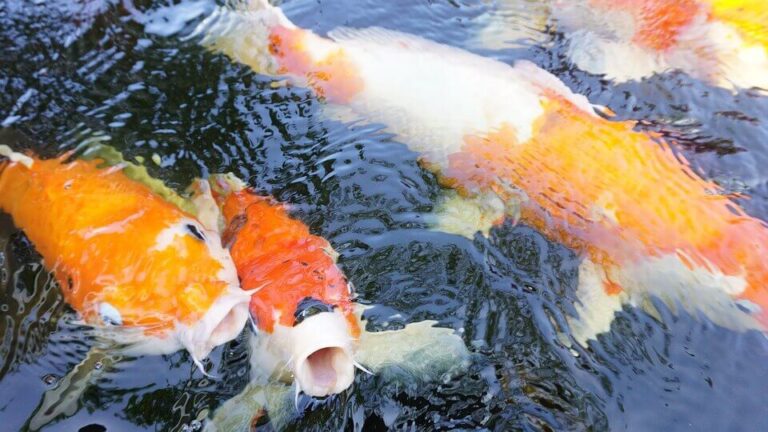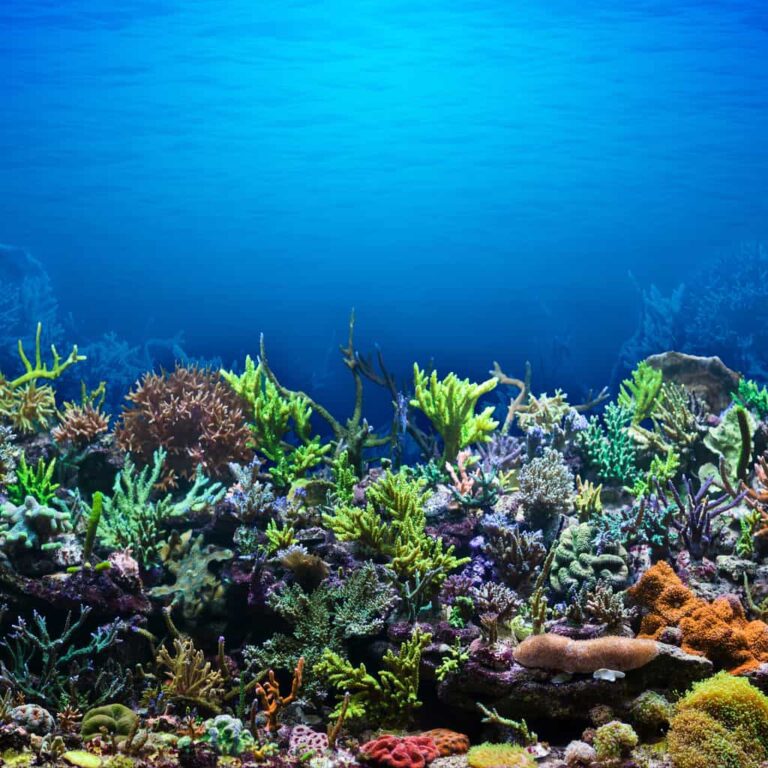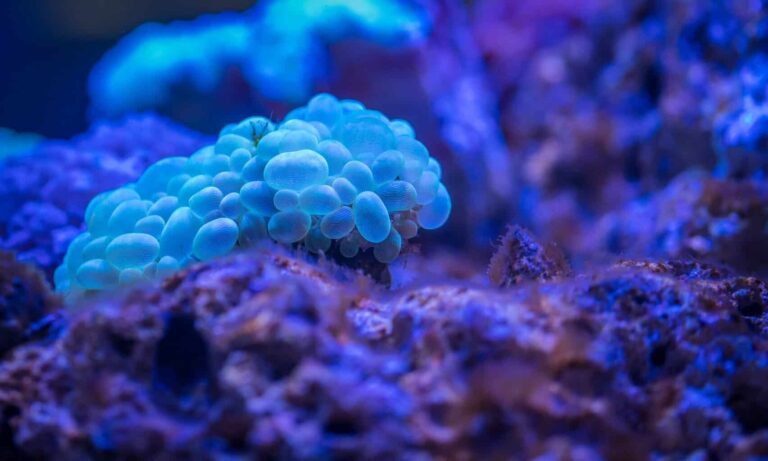Turtles are very distinctive animals, consisting of between 300 and 400 species (the actual number is debatable). Some can be found in rivers, lakes, and ponds while others live in the ocean. Turtles have been around for 200 million years!
They are divided into three categories that are sometimes wrongly referred to as real turtles, tortoises, and terrapins. There are dozens of pond turtle species, each with their own unique characteristics. For example: Box turtles, Mud turtles, European pond turtles, Cooter Turtles, etc.
Whether you are a first time turtle owner or have had turtles for many years, it is important to be able to identify the different types of pond turtles. And that’s exactly what we’re gonna do. So stick around with me!
20 Types Of Pond Turtle You Should Know About
Pond Turtles come in a variety of shapes and sizes. They may include freshwater and marine animals, as well as existing and extinct organisms. Turtles may be found practically anywhere on the planet, in almost every kind of climate.
A genus of reptiles called pond turtles is among the most basic, originating millions of years ago. They have been around since over 220 million years ago, and there are now more than 400 species surviving, including several critically endangered.
These are ectotherms with variable body temperatures. These are also categorized as amniotes, which means that they can lay eggs. Bony and cartilaginous skeletons are intertwined in their shell, which has two layers: Plastron and Carapace.
The skeleton is made up of 50 bones that are arranged and linked together.
Turtle shells’ primary purpose is to defend against external threats. A turtle is sometimes an animal with a mobile house connected to its back, which is a common misconception.

Turtles may be classified into three distinct categories, each with its own particular name:
1. Turtles
They have webbed feet and a light-streamlined shell that make them well-suited to living in the water.
2. Tortoises
They are specialized for xeric (land) existence, have round and short legs, as well as muscular forelimbs, which they use to dig burrows.
3. Terrapins
They are well-adapted for mesospheric existence, have round flippers along with light-webbed feet, light-weight shells with powerful forelimbs. They are most often found in rivers, marshes, ponds, and lakes, among other places.
Read our extensive guide on Turtle Vs Tortoise Vs Terrapin.
As long as you have the proper resources and infrastructure in place to handle turtles, they might be an excellent addition to your pond. It is impossible to explain all of the pond turtle varieties that exist; nonetheless, I tried to identify the most common types found across the globe.
All of these differences should guide your decision on which pond turtle to purchase, and they will be taken into account in the thorough list provided below.
1. Painted Turtles
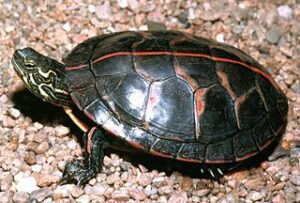
Many parts of the United States, as well as Canada and northern Mexico, are home to the painted turtle. It’s possible to buy them in the U.K.
However, keep in mind that they are an exotic species if released back into the wild. To keep painted turtles happy, you’ll want to keep their water temperature as close to 70 degrees Fahrenheit (21 degrees Celsius), which is why they’re known as painted turtles.
They’re little turtles, ranging in size from 5 to 7 inches, so they’ll fit in any pond. Their lifespan is usually more than 55 years. Compared to red-eared sliders (above), painted turtles are incredibly similar, except they miss the red ear markings and have an orange/red underside, whereas sliders possess yellow underbelly.
The tops of their shells are smooth and black, unlike those of regular freshwater turtles, which usually have a ridge. The legs of this creature are attractively painted with a variety of orange, red, and yellow stripes.
For their nutrition, painted turtles like slow-moving waters rich in algae and tiny insects, fish, and other small crustaceans. If you have turtles as pets, you may also provide them with turtle pellets as well as feeder fish.
The patterns on the shells of different subspecies make it easy to tell them apart. The upper shell segments of eastern painted turtles are arranged in a straight line. The red stripe on the southern painted turtle’s upper shell is a distinctive feature.
Western painted turtles have red patterns on the underside of their shell. Also, the midland painted turtle is known for having a substantial gray mark on the bottom of its shell.
2. Common Map Turtles

The map turtle is a relatively diversified variety of pond turtles, having patterns on the exterior surface of its shell that are often reminiscent of a map. On the other hand, their morphology may vary significantly, which is not surprising given the wide range of genera. These creatures are typically between 4 and 10.5 inches long and may live for between 15 and 100 years.
Even though map turtles are indigenous to the United States, these are marketed all over the world. They are less of a problem than most other freshwater turtles since they need high-quality water to exist and develop.
No wonder they’re so picky about different components of their habitat; they prefer temperatures between 72 and 80 degrees Fahrenheit (22 to 27 degrees Celsius). Diseases like shell rot as well as other bacterial infections might arise if their rigorous criteria are not maintained.
Aside from that, they choose sluggish water to motionless water. Map turtles are often found in slow-moving rivers and currents in the wild. As a result, pond owners considering keeping map turtles should consider installing a pump, cascade, or fountain to allow water to flow.
When raising adolescent map turtles, it’s important to remember that they need a diet primarily composed of plant materials. Food sources for the map turtle include water lettuce, duck-weed, water hyacinth, and frog-bit, which are all regarded to be essential. It is crucial to note, however, that these plants are frequently regarded as invasive. As a result, be sure that you comply with local standards before adding these plants into your pond.
The rest of the time, adults enjoy a variety of worms, crayfish, as well as insects. They also occasionally intake treats of kale, lettuce, and other vegetables.
3. Box Turtles

Unlike eastern box turtles, which are found only in the east region of the United States, box turtles are found only in North America. Because of a characteristic hinged bottom shell, they are readily distinguished by their huge, boxy shell, which may entirely surround themselves when closed.
The box turtle’s top jaw is also curved and wide when contrasted to the jaws of other turtles, which makes it an attractive predator.
Depending on their species, they are normally 5 to 7 inches in length and have a lifespan of 25 to 35 years.
Box turtles are members of the genus Terrapene, which includes numerous distinct species.
They have a varied diet that includes berries, slugs, snails as well as insects, among other things. Because of its poor reproductive rate, this species of pond turtle is now battling to sustain its population. For this reason, it is never advisable to capture a box turtle from its natural environment.
Because it is unlawful to collect wild box turtles, anyone interested in keeping box turtles as pets should seek legally acquired wild-caught box turtles from a reputable breeder or pet shop.
Although they are regarded as common pets, they may also be tough to keep in captivity. It is because the box turtle is frequently agitated, necessitates high levels of moisture, prefers certain kinds of soil, and does not like being handled.
Their temperature needs are also highly particular since they are naturally located in warmer regions of the United States.
4. Bog Turtles
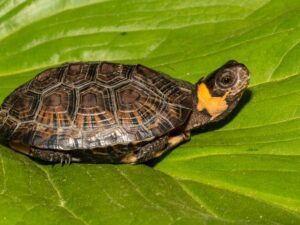
The bog turtle, which resembles painted and spotted turtles in looks, is the tiniest of its kind in North America. Boggy turtles have shells that are 10 centimeters (4 inches) long and weigh around 4 ounces. Skin, as well as shell, are usually dark brown, with a single orange patch on either side of the neck. They have a life expectancy of 20-30 years.
Invertebrates and bugs are the primary sources of nutrition for this omnivorous turtle.
The bog turtle, which may be found across the United States throughout Vermont and Ohio, is a reclusive creature that only emerges at night. During the colder months, they like spending their lives digging in the mud and hibernating.
Because of the elimination of the bog turtle’s native habitat due to urban expansion and invasive plants, the species’ continued survival is in jeopardy. Because they are deemed to be in such danger, they are preserved on a national level according to the U.S. Endangered Species Act.
However, demand for something like the bog turtle continues at an all-time peak on the black market. It’s mostly because of their tiny size and traits, while private programs are now ongoing to counteract the general reduction in their population.
5. Western Pond Turtles

Western pond turtles are known to sunbathe on stones and branches in floodplains, where they may be found in rivers, small lakes, streams, and ponds. It is also common to see the Western pond turtle (also known as the Pacific pond turtle) in irrigation canals, ponds, and marshes.
Generally, they are medium-sized pond turtles with dark streaks and black patches on their heads and yellow bellies. Gender differences in shell form are evident, with males having a flatter shell and a broader tail than females. In contrast, females have smaller heads, bigger dome-shaped shells, and flatter bellies than their male counterparts.
Most of the foods eaten by western pond turtles are those that they can readily overpower and capture of their own will. They only forage in the water and must devour the food they gather while submerged in it.
6. Cooter Turtles

River cooters are huge turtles with carapace lengths of up to 13 inches and occasionally more. They have pretty flat shells which flare at the back and are optimized for living in riverine or other flowing water environments, such as streams and rivers.
This species is brown to black on the shell and reddish on the plastron, with solid orange and black markings. The plastron’s edges might seem reddish from time to time. The stripes on the head are yellow. However, they may look orange to others. Depending on the subspecies, they may grow to be up to 16 inches in length and have a lifetime of 40 years or more.
7. Spotted Turtles
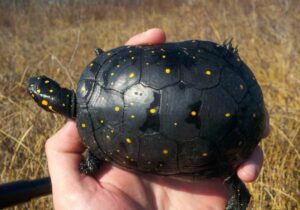
The spotted turtle is a tiny, semi-aquatic turtle with a smooth, wide top shell with black coloring that is smooth and broad. It is also possible for the carapace to be embellished with a variety of yellow dots that extend over the head, neck, as well as limbs of the creature. Depending on the species, its length may range from 3.1 to 4.7 inches, and its lifetime can extend from 25 to 50 years.
Spotted turtles are found in a variety of semi-aquatic habitats across the eastern part of the United States as well as the southern part of Canada, including marshes, bogs, wooded streams, ponds, as well as wetlands.
Using its head to explore aquatic vegetation, this kind of pond turtle hunts for food all over the water, searching for prey wherever it can find it. March through September are ideal feeding months, with temperatures averaging 58°F (14°C).
They are omnivore turtles that only eat in water; therefore, their diet is varied. In addition to aquatic vegetation, berries, and algae, spotted turtles eat a variety of other creatures such as worms, salamanders, spiders, crabs, insect larvae, and other small animals. In addition, they’re known to like eating tiny fish.
8. Wood Turtles
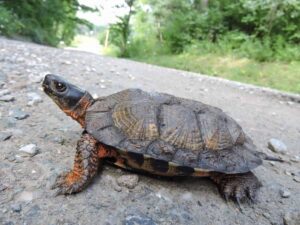
It is possible to find the wood turtle across its entire geographic range, extending from Minnesota through Nova Scotia and as far southward as Virginia.
This variety of pond turtles is distinguished by cone-shaped scutes on the top shell, which is unique to this species.
Like all other pond turtles, the pond turtle hibernates during the winter and basks in the sun during the warmest summer months. They typically measure 5.5 to 7.9 inches in length and may live for up to 50 years.
Wood turtles thrive in bodies of flowing water, particularly clean streams and big rivers, which provide the best aquatic habitat for them. It is generally recommended to prevent stagnant water since it may cause health issues and infectious diseases in the wood turtles, detrimental to their overall health.
9. European Pond Turtles

In Europe, the European-pond terrapin may be found in large numbers across the continent as well as northwest Africa, including the western and central parts of Asia. It is regarded as non-native in the United Kingdom.
However, this is because they were thought to have gone extinct in this region due to climatic cooling but have subsequently reappeared due to individuals who had them as pets releasing them into the wild to repopulate the area.
Also, since it was formerly a wild species in this area, releasing them wasn’t a bad idea (though you should never do the same with any pet turtle, regardless of breed!).
Most crucially, it is now unlawful to keep a European-pond terrapin as a pet, irrespective of where you reside, as part of the ongoing campaign to protect the species in its natural environment.
The fact that it can still be available for sale and is considered a popular pet in many locations is why I placed it on our list, although you should note that this breed should not be maintained as a pet.
10. Snapping Turtles

Snapping turtles are another renowned and widespread species of reptiles. They are well-known for the incredible ferocity of their bite and the speed with which they attack.
This turtle may grow to be 45 pounds in weight and 14 inches in diameter. A fish swims by, and they wait patiently for it to pass by before snatching it.
Even though they are huge turtles, they are still capable of swimming and even walking at high speeds. They are designed to be the most lethal killing machine possible—razor-sharp teeth, a tough shell, and lightning-fast reflexes.
They like to conceal themselves in dirt and mix in with their surroundings. If there are just a few inches of still water, they may become undetectable. A snapping turtle has the power to remove a finger from its victim’s hand altogether. Thus you should avoid coming into contact with them.
They are carnivores, which means they only eat fish, rodents, snakes, and other turtles.
Snapping turtles should not be kept in ponds because they will consume any fish that passes past their face. Even though they are fascinating creatures, they do not fit in recreation ponds.
11. Mud Turtles

Mud turtles are a kind of semi-terrestrial freshwater turtles belonging to the Kinosternidae family that may be found across the northern part of Argentina, including North and South America. There are 18 different forms of mud turtles.
Like the musk turtle, the mud turtle is a little creature that may grow to be just 6″ (15 centimeters) in length or less. Furthermore, in contrast to musk turtles, their bottom shell has a hinge on each end. Whenever the mud turtle feels attacked, they may use this to defend their head, tail, as well as legs.
This omnivore turtle has a strong preference for animal meat and eats a variety of foods such as worms, arthropods, fish, as well as fish eggs.
Mud turtles are poor swimmers that prefer to stroll on the water’s surface.
12. Musk Turtles

The musk turtle, sometimes known as the stinkpot, has a natural tendency to emit a foul stench to deter predators, which has earned it the nickname. Aroma glands are found around the edge of its highly curved shell, and they are capable of generating a musky scent when activated.
This tiny turtle species, a member of the Kinosternidae family, is endemic to a vast stretch of the eastern part of the U.S.A. and southeastern part of Canada and is classified as endangered. They’re generally grey, black, or brownish in color and have long necks with tiny legs.
The length of their shell ranges from 2 – 5 1/2″ (5 to 14 centimeters) in length, with a maximum weight of 3/4pounds (12 ounces).
However, although the musk turtle is largely a carnivore as an adult, they are regarded as even more carnivorous while hatching. In addition to eating crayfish, aqueous larvae, snails, insects, as well as clams, as they get older, a mature musk turtle will learn to love the flavor of aquatic plants after reaching adulthood. They also like to eat tadpoles, fish, and dead animals, among other things.
In many ways, this is one of the most appealing turtle species to keep as a pet since it is one of the tiniest on the list. To be honest, this may not be the creature for you if you’re seeking something to gaze at all the time since it is an underwater inhabitant that spends much of its time hiding down at the bottom of the ocean.
13. False Map Turtle

False map turtles are so named because their shells have a design that resembles a false map. Sawback turtle is another name for this species. There is nothing aggressive about false map turtles, and they never bite.
With more significant body proportions, they have a life expectancy of 20-30 years. Female companions are somewhat bigger than male lovers, despite just being a few inches taller on average.
The dorsal shell covering the turtle’s carapace exhibits a variety of colors ranging between brownish-green and olive. It is also typical to see a yellow marker having dark borders on display as well. Instead, the top surface of shell-plastron might be any hue from yellow to cream in appearance.
The plastron of the adolescent species of the false-map turtle is patterned with black lines that dart down along the seams, creating a distinct pattern. At the upper rear of the eyes, these black lines appear a curved backward L.
These turtles are aquatic creatures that need an aquatic habitat that is well-filtered and has a constant water flow. Having a larger female companion makes things a little more complicated since it necessitates a larger tank in comparison.
Although these false-map turtles are excellent swimmers, they, nevertheless, need logs or other objects in their surroundings to rest and bask. Basking provides them with the necessary relaxation, healing, and shell repair.
They seem to be more vulnerable than other pond turtles, such as painted and slider turtles, to sickness, wounds, and shell injury. To keep them as pets, you’ll need to have huge tanks.
A high water level is preferable for these pond turtles since it allows them to swim and maintains their high aquatic character.
Pond turtles want clean freshwater that has a level surface on which they may bask. In most cases, sunbathing and swimming exercises are sufficient to keep the false-map turtle’s temperature stable.
It is possible to reduce sunlight and maintain temperatures that are appropriate for basking by using a high-quality UVB lamp equipped with a night-stimulating timer. Maintaining high amounts of oxygen in water is possible by adding certain aquatic plants to the pond.
14. River Cooter

An herbivorous turtle, the Eastern River Cooter turtle, may be found in freshwater. You may find it in lakes, ponds, coastal marshes, and rivers, among other places.
Sunbathing on fallen leaves, rocks, logs, and other such objects may be observed, but it immediately returns to the water as the sun goes down.
Because it prefers a watery environment, scientists have found it challenging to study it.
Their shell has a slight dome shape to it. The color of its ventral layer of the shell ranges from olive to brown, with variations in creamy-yellowish markings.
Male members above the age of 50 had darker skin tones than female members.
Females are bigger than males, even though the male tail is bigger.
Many subspecies are known for their distinctive appearances, including the Missouri-River Cooter, the Hieroglyphic-River Cooter, the Rio-Grande Cooter, and the Mobile-Bay Cooter.
Because of their herbivorous nature, cooter pond turtles eat algae crustaceans, plants, and aquatic grasses in addition to other animals.
This species has a tooth-like cusp located at the top of the upper jaw of the mouth. This aids in the chewing of herbs by a cooter pond turtle.
Fresh vegetables are encouraged, whereas bread, refined candies, chocolates, or other sugary foods should be avoided, while you should avoid milk or even a milk product as much as possible.
In the spring, the cooter pond turtle dips into the water to breed with its mate.
Immediately after pairing, the female dug up sand close to the water and laid 12-20 eggs, which hatch in 45 to 60 days. Predators that they may encounter include raccoons, alligators, falcons, and muskrats.
15. Japanese Turtle (Japanese Pond Turtle)

Japanese pond turtles (Shigame) may survive in cold, fast-flowing ponds and streams as well as irrigation canals, lakes, and ditches that have been constructed artificially.
It is often referred to as a Japanese-stone turtle since its shell looks like stone.
The capacity of the Japanese Pond turtle to hibernate at the base of ponds and streams is a unique adaptation that has developed through time.
They do not breathe in the bottom layer of water; instead, they use their tail to collect oxygen from the water, which allows them to survive.
The Japanese-pond turtle is native to Japan and is found mainly on Kyushu-Shikoku as well as Honshu. They are also common household pets, particularly in Japan.
The scientific name for this pond turtle is Mauremys japonica. It is a member of the Geoemydidae family and is found in Japan. The lifetime of a Japanese-Pond turtle is around 20 years on average.
The Japanese-pond turtles, which are members of the Geoemydidae family, are all of the intermediate sizes.
The lower shell-carapace layer of adult females is roughly 20 centimeters (7.9 inches) long, whereas males are around 14 centimeters (5.5 inches) long.
Although their heads are olive-brown in hue, their carapace varies in color from rocky, gray, brown, dark brown, including black.
An apparent characteristic is a single serrated ridge at the rear end of the shell. Tails are primarily present on the male and female, with the males being somewhat longer.
There are orange lines on each of their webbed feet in this species.
In addition to eating mature frogs and fish, the wild Japanese pond turtle likes to consume larvae, prawns, and crayfish as well as aquatic insects, water plants, and algae. It will also intake fruits and vegetables.
They also consume fruits such as watermelon, plums, berries, and grapes, as well as vegetables like lettuce, shredded carrots, green pepper, cabbage, spinach, and green beans.
They feed both in the water as well as on the dry surface of the water, or they may eat both at the same time. You can provide them with a range of foods.
Japanese pond turtles are found in freshwater ponds and streams that have a wide range of temperatures. They can withstand the frigid temperatures of freshwater ecosystems with ease. Because of their adaptability, they may rapidly get adapted to fast-flowing water.
The most intriguing characteristic of Japanese Pond turtles is that they are excellent swimmers.
For a Japanese Pond Turtle, a 50-gallon aquarium with 50 sq. ft. of water is required. To adopt this turtle species, you need a vast space. A layer of gravel or other ornamental materials might be placed at the bottom of the pile.
This pond turtle requires 10 gallons of water per inch of body length. Even though they spend most of their life in the water, it does need time to bask. As a result, the basking area may be kept at a size that allows them to move and reach it with relative ease. You may also use UVB light to aid in the process of basking.
Even though they are well-adapted to freezing temperatures, you must provide them with a comfortable habitat. The water should be approximately 77°F, and the basking zone should be around 80°F, max 85°F.
The mating season for Japanese turtles begins in September and concludes in April of the following year. In a typical year, a female lays 3 to 8 eggs in each of her four clutches, depending on her size.
Like many other aquatic turtles, the Japanese-pond turtle seems more like a predator than just a prey species. They often hunt fish, tadpoles, aquatic insects, fronts, mollusks, and other tiny amphibians.
16. Slider Turtles
There are two types of slider turtles often seen in ponds: the yellow-bellied and the red-eared varieties. A healthy mix of food, land, as well as water, is essential for slider turtles to thrive in both hot and cold climates, regardless of species. Because of their wide range of food preferences, they are a popular choice for enthusiasts. Their size varies by subspecies, and their lifespan ranges from 20 to 30 years and more.
17. Yellow-Bellied Slider

Yellow-bellied pond turtles live in warm freshwater. The scientific name for this species is Trachemys scripta elegans. It is commonly known as the slider or yellow-bellied terrapin.
An adult yellow-bellied pond turtle may live between 25 to 100 years. Its female companion is 8-13 inches bigger than its male counterpart in terms of height (5-8 inches).
The yellow-bellied pond turtle needs a high-protein diet to grow and develop appropriately at a young age. They like to get their protein from meat. Their preferred food items include amphibian larvae, snails, as well as mollusks. They also like tiny fish, crabs, worms, and daphnia, among other creatures.
When they reach adulthood, they switch to a plant-based diet rich in vegetables, algae, and other plants. They like warm water and sunbathing on logs.
Despite being friendly creatures, they may bite you, causing you to have painful fingers.
Also, it is essential to provide the pet with a well-filtered system due to the amount of waste they create. They need a big aquarium or pond because they require a huge area to exercise as well as a separate place for basking.
When dealing with several turtles, it is necessary to modify the configuration to be the most effective.
18. Red Eared Slider

Turtles of the red-eared slider species are the most common in North America. It is pretty resilient and may be found in almost any body of water, whether it is fresh or salt.
Generally, the red-eared slider is regarded as a medium-sized turtle with a 5-11 inches diameter. Males are usually much smaller than females, which makes it simpler to distinguish from one another.
They will consume nearly everything that is placed in front of them. They are omnivores, which means that they will consume both smaller fish in a pond as well as any aqueous plants that they come across. I suggest providing them with various fruits 1-3 times each week to keep them from eating all of your pond plants.
Red-eared sliders, like other turtles, spend the majority of their time lounging in the sun. If you wish to preserve these turtles, you must provide them with a secure environment where they may bask in the sun for several hours each day. As a basking area, a few boulders elevated above the edge of the water will suffice.
Red-eared sliders are an excellent choice if you want a sturdy turtle that is also simple to care for. They are simple to maintain and may contribute significantly to the environment
19. African Side-necked Turtle
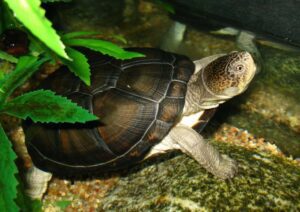
Most of the pond turtles depicted on this page are indigenous to North America; however, this particular turtle is indigenous to Africa, as its name indicates. Furthermore, to be more specific, this turtle may be found in the wild in broad swaths of the East and Southern part of Africa.
These turtles may grow pretty big, ranging in size from 8 to 18 inches in length. The combination of their large size and dominant nature may sometimes result in them being hostile when housed with other small turtles.
Their species-specific confinement generally solves this issue. They make excellent pets since they are inherently curious and social creatures, which means that they will willingly associate with people and will not be intimidated by more crowded environments.
Their name derives from their inability to retract their heads inside their shells properly. Their neck will be pulled back as much as possible so that they may lay on their side to protect themselves.
It is common for them to spend extended periods out of the water, lounging in the sun, as a kind of devotion. There should be many appropriate sun-lounger spots around your garden pond to give a comfortable environment for these turtles.
Typically, they are only ideal for warm areas where the water temperature keeps below 70 degrees Fahrenheit. Because they would not normally hibernate, you might shift them into a warmer section of the house if winter circumstances get too difficult
20. Western-Painted turtle
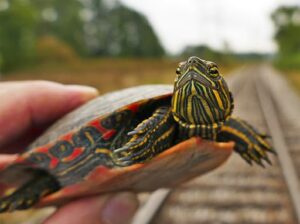
If you genuinely want to add a touch of glitz and glitter to your pond, you might think about including one of these Western painted species into the mix. Even though this turtle is not exceptionally huge, measuring only up to 10 inches long at the most, it is an adorable species.
Light-colored patterns on a black backdrop characterize their skin, and their shell is renowned for its unique and complicated markings and patterns.
These turtles are considered to be among the nicer turtles to adopt as pets. They appreciate the frequent treatment and may even create a good relationship with their handler that distinguishes them from other animals. If properly cared for, they may live approximately 50 years in a backyard pond.
This includes providing enough room for roaming as well as ensuring proper filtration and oxygenation of the water supply. An overpopulation of turtles in a small region might cause resource depletion.
Look up the details on red-eared sliders if you become confused about what type of needs it has since they have pretty similar requirements to red-eared sliders.
Unlike most other species shown here, this subspecies of the abovementioned painted turtle is endemic to Canadian locations such as British Columbia, which allows it to survive in considerably lower temperatures than most other species. This may make it more suited to export to less sunshine places, such as the United Kingdom.
Purchasing Pond Turtles: What To Keep In Mind
When selecting a turtle species for your pond, it is essential to ensure that it will not leave the pond zone. Because it might become an endangered species and cause significant harm to the local ecosystem.
There is a possibility that some of the species offered as pets are indigenous to your region. For example, a popular pet species like red-eared sliders, which are native to most of the United States and Mexico.
Basking locations with lots of sunshine in the pond are required for all of the turtles mentioned here. Basking is vital for turtles to ensure a healthy metabolism as well as skin and help in appropriate digestion.
Also, be aware that unlawful turtle pet trafficking is a significant problem and is responsible for the extinction of many turtle populations and species. Only buy turtles that are indigenous to your nation and ethically raised in captivity, not taken from delicate wild populations.
We’ll go over some of the freshwater-pond turtles as well as terrapin species that are appropriate for incorporating into your pond’s environment.
Taking Care of Pond Turtles
Worldwide, turtle populations are under severe danger from habitat loss, deterioration, and degradation in general. They are also threatened by poaching and unlawful black market pet trafficking, as with most other reptile species. Approximately 60 percent of the total freshwater turtle species are vulnerable or threatened.
Sounds sad, doesn’t it? This is all the more reason that you should cherish your little friends and take good care of them.
It doesn’t matter which of the above species of pond turtles you choose to maintain; there are a few essential aspects to keep in mind at all times.
1. Verify if the turtle is native or not
First and foremost, you should try to retain turtles that are local to your region if at all feasible.
The species has already been adopted and is suitable for the location, benefiting the native fauna and ecosystem. You won’t have to be concerned about whether or not the temperature will be favorable or whether or not local predators will pose a threat to your pet.
It also means that if your pet does manage to escape, it will not be as problematic. If a non-native turtle manages to get out of captivity, it may be classified as an invasive species, which might have serious long-term consequences if the turtle goes on to reproduce in the wild.
2. Be mindful of the surroundings
Take into consideration the space needs of your turtle as well. Some turtle species need a considerable dry ground to bask in, but others require only a small amount of dry land. Similarly, some turtles need just a tiny amount of space to swim about in, while others demand a bigger pond.
It mainly depends on the turtle’s size, although it isn’t the sole consideration.
Also, don’t ignore the pond’s depth. While certain species prefer a deep pool, others prefer wandering in shallow water and yet feel the sun’s warmth on their backs. You may need a combination of the two.
It becomes necessary to consider other considerations as well. Consider how your turtles will enter and exit the pond, for instance. You will need a piece of the pond with a slight slope to enable them to enter and leave the pond with ease.
3. Feed your turtle well
After that, conduct some study into the specific nutrition that your turtle needs to survive. Generally, generic turtle pellets are suitable for a wide range of species, although particular breeds may have specific nutritional needs and requirements of vitamins, minerals, and other components.
Turtles will happily eat algae and insect larvae. Adding turtles to your pond may help protect a variety of species and provide several environmental benefits by reducing the number of algae and insects in your pond.
You can check my article on what do pond turtles eat for some clear insight.
Climate Factors That Affect Turtles
Putting an aquatic turtle outside during the summer season may only be possible for several months, depending on your location and how hot it gets in your area. If you have a breed, you must take into account its natural habitat. Red-eared sliders, for example, are a formidable and adaptable species to live with.
If you insist on keeping your turtle outside since it is used to higher temperatures, you must consider the species’ native habitats before making the decision. If you reside in a warmer region, you may be able to keep your aquatic turtles outside all year.
Hibernating certain species in an open pond is also conceivable, but it comes with its own set of challenges and risks.
Safety Tips For Pond Turtles
Keeping pet turtles in outdoor ponds necessitates the use of a secure fence. The pond should be surrounded by a fence 2 to 3 times the length of your turtle’s shell and buried six to ten inches into the ground to ensure that your turtle cannot escape.
With a strong foundation, turtles won’t get trapped in the wire of the fence. This fence aims to discourage turtles from wandering in quest of a mate and serves as a barrier for predators.
If you have raccoons or other predators in your backyard, you may want to use a pond cover to keep your turtles safe. Turtle hatchlings and adolescents should be kept inside until they have grown to a reasonable size to protect them from predators.
Final Words
Whether you choose the enormous and imposing red-eared slider or the smaller and more delicate musk turtle, you should be sure that you are competent in caring for these animals.
The appearances of several of them are rather pleasant, while the personality of others is appealing and kind. Which types of pond turtles you want for yourself is entirely up to you the characteristics and attributes you choose to emphasize.
So, if you want to add some life to your weary old pond, be sure to choose an appropriate type from this list of suggested pond turtle species to get started.

